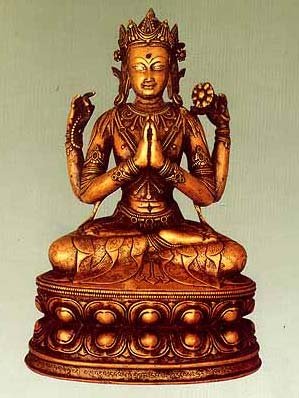Guhyasthana, Guhyasthāna, Guhya-sthana: 2 definitions
Introduction:
Guhyasthana means something in Buddhism, Pali, Marathi. If you want to know the exact meaning, history, etymology or English translation of this term then check out the descriptions on this page. Add your comment or reference to a book if you want to contribute to this summary article.
In Buddhism
Mahayana (major branch of Buddhism)
Source: De Gruyter: A Buddhist Ritual Manual on AgricultureGuhyasthāna (गुह्यस्थान) refers to a “secret place” (suitable for enchantment ceremonies), according to the Vajratuṇḍasamayakalparāja, an ancient Buddhist ritual manual on agriculture from the 5th-century (or earlier), containing various instructions for the Sangha to provide agriculture-related services to laypeople including rain-making, weather control and crop protection.—Accordingly, [as the Bhagavān teaches various Nāga-enchantments], “[...] The image of five Nāga girls should be placed in a secret place (guhyasthāna). Flowers and incense should be offered. It should be kept in a calm place, without having been perceived; nobody should be offered a sight of it. It should be covered with a clean cloth. If there is need, it should be struck with mustard seeds enchanted 108 times. It will accomplish all enterprises. [...]”

Mahayana (महायान, mahāyāna) is a major branch of Buddhism focusing on the path of a Bodhisattva (spiritual aspirants/ enlightened beings). Extant literature is vast and primarely composed in the Sanskrit language. There are many sūtras of which some of the earliest are the various Prajñāpāramitā sūtras.
Languages of India and abroad
Marathi-English dictionary
Source: DDSA: The Aryabhusan school dictionary, Marathi-Englishguhyasthāna (गुह्यस्थान).—See upastha.
Marathi is an Indo-European language having over 70 million native speakers people in (predominantly) Maharashtra India. Marathi, like many other Indo-Aryan languages, evolved from early forms of Prakrit, which itself is a subset of Sanskrit, one of the most ancient languages of the world.
See also (Relevant definitions)
Relevant text
Search found 1 books and stories containing Guhyasthana, Guhyasthāna, Guhya-sthana, Guhya-sthāna; (plurals include: Guhyasthanas, Guhyasthānas, sthanas, sthānas). You can also click to the full overview containing English textual excerpts. Below are direct links for the most relevant articles:
The Skanda Purana (by G. V. Tagare)
Chapter 26 - The Glory of Mandākinī-Kṣetra < [Section 1 - Avantīkṣetra-māhātmya]